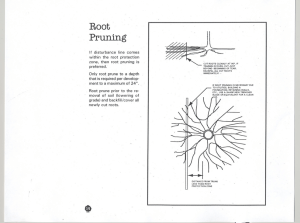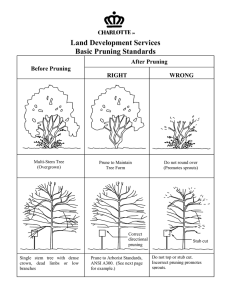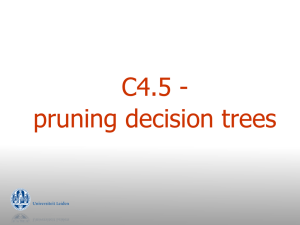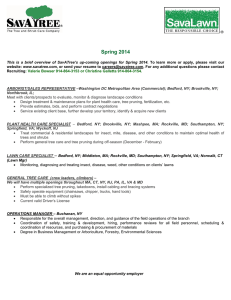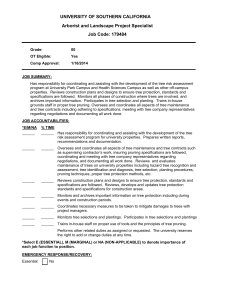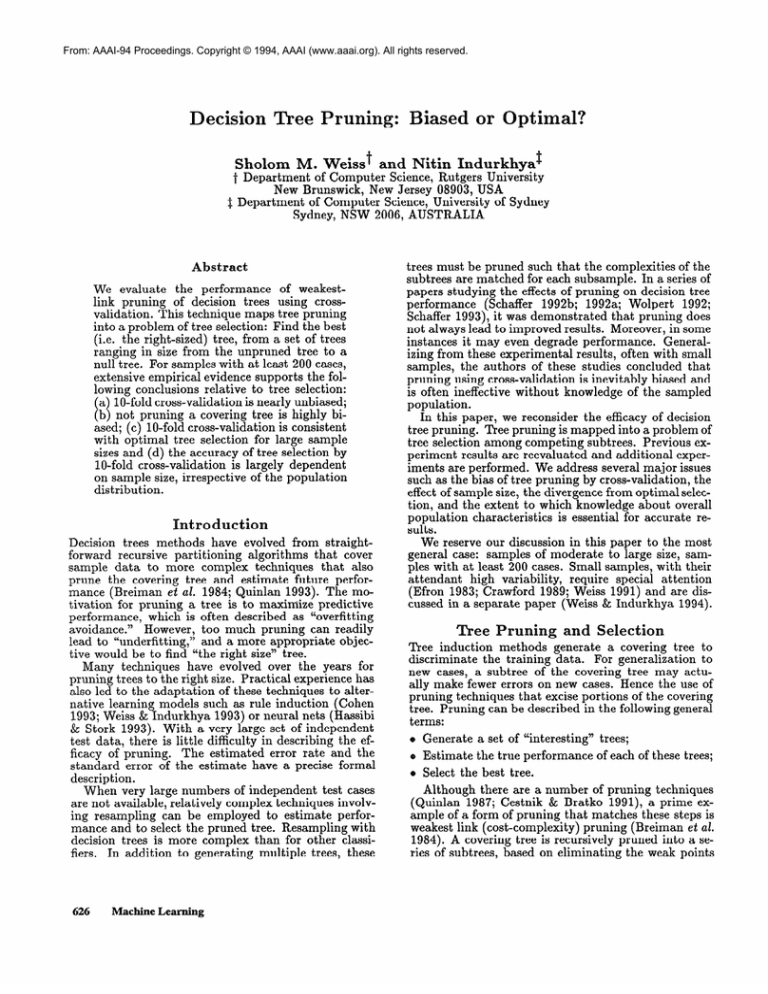
From: AAAI-94 Proceedings. Copyright © 1994, AAAI (www.aaai.org). All rights reserved.
Decision Tree Pruning: Biased or
Sholom
M. Weiss t and Nitin Indurkhya $
0 Department
of Computer Science, Rutgers University
New Brunswick,
New Jersey 08903, USA
$ Department
of Computer Science, University of Sydney
Sydney, NSW 2006, AUSTRALIA
Abstract
We evaluate
the performance
of weakestlink pruning of decision trees using crossvalidation.
This technique maps tree pruning
into a problem of tree selection: Find the best
(i.e. the right-sized)
tree, from a set of trees
ranging in size from the unpruned tree to a
null tree. For samples with at least 200 cases,
extensive empirical evidence supports the following conclusions
relative to tree selection:
a lo-fold cross-validation
is nearly unbiased;
flb not pruning a covering tree is highly biased; (c) lo-fold cross-validation
is consistent
with optimal tree selection for large sample
sizes and (d) the accuracy of tree selection by
lo-fold cross-validation
is largely dependent
on sample size, irrespective of the population
distribution.
Introduction
Decision trees methods
have evolved from straightforward recursive partitioning
algorithms
that cover
sample data to more complex techniques
that also
prune the covering tree and estimate
future performance (Breiman
et ad. 1984; Quinlan 1993). The motivation for pruning a tree is to maximize predictive
performance,
which is often described as “overfitting
However, too much pruning can readily
avoidance.”
and a more appropriate
objeclead to “underfitting,”
tive would be to find “the right size” tree.
Many techniques
have evolved over the years for
pruning trees to the right size. Practical experience has
also led to the adaptation
of these techniques to alternative learning models such as rule induction (Cohen
1993; Weiss & Indurkhya 1993) or neural nets (Hassibi
& Stork 1993). With a very large set of independent
test data, there is little difficulty in describing the efThe estimated
error rate and the
ficacy of pruning.
standard error of the estimate have a precise formal
description.
When very large numbers of independent
test cases
are not available, relatively complex techniques involving resampling
can be employed to estimate performance and to select the pruned tree. Resampling with
decision trees is more complex than for other classifiers. In addition to generating
multiple trees, these
626
Machine Learning
trees must be pruned such that the complexities of the
subtrees are matched for each subsample.
In a series of
papers studying the effects of pruning on decision tree
performance
(Schaffer
1992b;
1992a; Wolpert
1992;
Schaffer 1993), it was demonstrated
that pruning does
not always lead to improved results. Moreover, in some
instances it may even degrade performance.
Generalizing from these experimental
results, often with small
samples, the authors of these studies concluded that
pruning using cross-validation
is inevitably biased and
is often ineffective without knowledge of the sampled
population.
In this paper, we reconsider the efficacy of decision
tree pruning. Tree pruning is mapped into a problem of
tree selection among competing subtrees.
Previous experiment results are reevaluated and additional experiments are performed.
We address several major issues
such as the bias of tree pruning by cross-validation,
the
effect of sample size, the divergence from optimal selection, and the extent to which knowledge about overall
population
characteristics
is essential for accurate results.
We reserve our discussion in this paper to the most
general case: samples of moderate to large size, samples with at least 200 cases. Small samples, with their
attendant
high variability,
require special attention
(Efron 1983; Crawford 1989; Weiss 1991) and are discussed in a separate paper (Weiss & Indurkhya 1994).
Tree Pruning
and Selection
Tree induction
methods
generate a covering tree to
discriminate
the training data.
For generalization
to
new cases, a subtree of the covering tree may actually make fewer errors on new cases. Hence the use of
pruning techniques that excise portions of the covering
tree. Pruning can be described in the following general
terms:
e Generate
a set of “interesting”
o Estimate
the true performance
e Select
trees;
of each of these trees;
the best tree.
Although there are a number of pruning techniques
(Quinlan 1987; Cestnik & Bratko 1991), a prime example of a form of pruning that matches these steps is
weakest link (cost-complexity)
pruning (Breiman
et al.
1984). A covering tree is recursively pruned into a series of subtrees, based on eliminating
the weak points
results of 10 runs using go-percent training and lopercent testing cases, with 10 mutually exclusive test
partitions)
has been widely used for many different
learning models.
Our objective
in the remainder of this paper is to
compare
the performance
of tree pruning for these
three alternative
methods of estimating error rates.
Basic Principles
St at ist ical Model
Fundamental
Evaluation
Table
1: Example
of Summary
Table for Tree Pruning
of the current tree. These weak points are determined
strictly from the training data.
Having obtained a set of decision trees, (To,. . . , T!)
one is now faced with the tree selection problem: given
a set of trees, select the best one. The usual definition
of best is that of the minimum true error rate, which
must be estimated.
It is useful to order the set of
trees by some complexity measure such as tree size. If
the set of trees is obtained by pruning, then To is the
unpruned covering tree, and T, is a tree that consists
only of the root node. Figure 1 gives an example of
a pruning summary
table, such as found in CART,
with the covering tree To having 18 terminal nodes
and T8 representing
the fully pruned tree with a single
terminal node. Err test is the estimate of the true error
rate for each tree, and TestsE
is an estimate of the
standard error of the error rate. In this example, T3
is selected because it has the minimum estimated true
error rate.
Thus, tree pruning is mapped into a problem of tree
selection:
Find the best tree, i.e the right-sized tree,
from a set of trees ranging in size from the unpruned
tree to a null tree. Tree selection does not depend on
the techniques for generating the trees. Error estimation is the sole basis of tree selection;
the tree with
the lowest error-estimate
is selected.
The quality of
the results depends on the accuracy of these estimates.
Several error-estimation
procedures might be hypothesized:
Ideal: The ideal situation occurs when an oracle is
available that can tell us the future performance
of
each decision tree.
Then we will be able to make
the optimal tree selection.
Such an oracle is usually
approximated
accurately by testing each tree, Ti, on
a very large, independent
test set.
NP: While we would like to use an oracle-based
method, this may not be possible if insufficient cases
are available.
One strategy might be to base decisions on the apparent error for the training cases.
Because the apparent error rate is minimum for the
covering tree, this strategy reduces to not pruning
the initial covering tree.
Cross-Validation:
When large numbers of independent
test cases are not available,
resampling
methods are the principal technique for error rate
estimation.
Cross-validation
is generally the procedure of choice, and lo-fold cross-validation
(the test
of
The standard model of evaluation
of a learning system is by testing on an independent,
randomly drawn
sample from the general population.
If performance
is
measured in terms of a proportion
of failure, i.e. an
error rate, then the situation corresponds
to the binomial sampling model. This testing situation is the
standard statistical
coin tossing problem, where here
we “toss” the classifier on each of the test cases. If we
have n test cases, then there are n success or failure
outcomes,
each outcome representing
a correct or incorrect classification
of a test case. The standard error
of this proportion is given in Equation 1, where n is the
test-set size and p is the true error rate. For a given
sample size, the standard error roughly tells us the average amount that the error rate will diverge from the
truth.
Variance
- P)
= PO
-;
SE = &ariance
n
(1)
We have a statistical- model of how far off the error estimate for a single test sample is from the truth.
With unlimited test samples, the efficacy of pruning
would be obvious. The pruned tree with the minimum
test error is the best to a very high degree of confidence.
Just based on the variation among random samples,
the error rate on test cases will vary from the truth
according to Equation 1. This variance is based solely
on two terms, the true error rate, p, and the test size
n. Considering
the range of p, the worst case (i.e. the
highest variance) is for p=.5. However, the true error
rate, p, has a relatively minor effect on the variance,
and the key factor is n, the test-set size. The accuracy
of the evaluation on the test cases is mostly determined
by test-sample
size. When n is large enough the standard error becomes quite small.
Given only a single sample, without large numbers
of test cases, the task is to estimate
the true error
rate. Resampling
techniques
such as cross-validation
attempt to approach the performance
of testing on the
same number of independent
cases, while still using
the full sample for training purposes.
Resampled estimators are still subject to the random variation of
the sample.
At best, the resampled estimates reflect
the error-rate
for treating the sample as an independent test set. Their variance from the true error-rate
would approximately
follow Equation 1, their accuracy
mostly dependent on the sample size n, and independent of the original population distribution.
Estimation
and Tree Selection
ias and Consistency
of Estimators
tor, 2, of a metric (such as an error-rate)
An estimais unbiased if
Decision-Tree
Learning
627
its expected value i.e. the average of its values over
all samples) is equa \ to the true value of the metric. If
sufficient number of independent
random samples, N,
are used, then for an unbiased estimator.
Eauation 2.
summarizes this relationship,
where z is the &timator:
Xi is its mean value for the i-th sample, T(z) is the
true value of the metric being estimated by z and N
is the number of samples.
T()- c;,xi
X-
N
The key concept of an unbiased estimator
is that
over a large enough set of independent
samples it averages to the true answer.
It may vary from sample
to sample, but over all samples the average is correct.
An example of an unbiased estimator is the error-rate
estimate on an independent
test set. While the estimate from a particular test set mav differ from the true
value, the average value of the eitimate
over all POSsible (independently
sampled) test sets is the same as
the true value. There is some empirical evidence that
suggests that cross-validated
estimates
are relatively
unbiased under quite general conditions (Efron 1983).
While an unbiased estimator
averages to the the true
value, it is also desirable that the estimate tend to be
close ‘to the true value. Equation
1 shows how close a
typical estimate will be for a given sample size.
Another desirable statistical
property of an estimator is consistence:
results improve with increasing sample size. For example, error-rate
estimation
frgm an
independent
test set is consistent.
As the test-sample
size increases,
the error-rate
estimate varies less and
less from the true error-rate.
Optimality
and Unbiased Tree Selection
Pruning can be posed as a problem of tree selection with the
objective of minimizing the true error rate. An optimal
procedure always selects the best tree from the-set of
pruned trees generated for a sample. Such a procedure
would be obtained if ideal error-rates
were available.
In their absence, we must rely on estimates.
While we may use estimates of error rates for tree
selection and pruning, the absolute magnitude of these
estimates is not critical.
Instead, the relative ranking
is critical.
As long as the relative ranking (in terms
of error-rates)
of the pruned trees is correct, then the
right-size tree can be selected.
If estimators
are used
for tree selection, the tree selection bias should be measured. An appropriate
measure of bias is the average
size of trees that are selected.
An optimal tree selection procedure will always select the right-sized
tree
for each sample.
However, an unbiased procedure is
not necessarily
optimal.
An unbiased procedure may
select the wrong-sized tree for any given sample. Although these trees may range from undersized to oversized, the procedure can be considered unbiased if the
average size over many samples is correct.
Bias is one of two principal components
of error in
estimation.
The other is variance.
As indicated by
Equation
1, samples randomly drawn for a large population will vary. They are not a perfect reflection of
the general population.
The variance decreases with
increasing sample size. Thus, it is not unusual when
we flip an honest coin ten times, that we will see seven
628
Machine Learning
I Yeature
Cases
LED
Noise
1 pgm/lOOOO
5000
Table
2: Dataset
7
10
Boolean
Numer.
I
1
10
2
Characteristics
heads. But if we flip it a thousand times, we are far less
likely to see seven hundred heads. When the sample
size grows large, the variance decreases greatly. An unbiased strategy with zero variance is an optimal strategy. As the sample size increases, the variance should
move closer to zero and an unbiased strategy should
also approach an optimal strategy.
The classical formal definition
of statistical
bias
may differ from the descriptions
given in the machine learning literature (Schaffer 1993; Mitchell 1990;
Utgoff 1986), where a reader might conclude that unbiased estimators
are optimal.
The fundamental
statistical concept of bias recognizes that predictive error is
not attributable
solely to the bias of a decision model.
Instead, the problem may be with the sample! Inaccuracy of estimation
can be a byproduct
of random
sampling variance, particularly
for small samples that
diverge greatly from the general population characteristics.
With a large enough sample, an unbiased tree selection strategy should approach an optimal solution,
but an unbiased strategy will not always beat a biased
strategy. If the bias fits the characteristics
of the population, then for samples drawn from that population,
the biased strategy will be closer to the truth. For example, if someone always calls heads, then with a coin
slightly biased for heads, that strategy should be superior. With a large enough sample of coin flips one
would discover this, but for smaller samples inferior
performances
for unbiased guesses are unavoidable.
Sources
of Error in
Even with unbiased estimation
techniques,
all induction and pruning algorithms
are at the mercy of the
random variance of a sample.
There is also another
inherent source of error. When estimating error rates,
cross-validation
will train on less than the full sample.
During each train and test cycle, some of the data must
be reserved for testing. The usual variation is lo-fold:
90% training and 10% percent testing.
For error rate
estimation,
this means that the estimates are those for
90% trees, not 100%. Thus these estimates should be
somewhat pessimistic.
For tree selection and pruning,
the situation may be somewhat better.
The relative
ranking is critical, not the absolute magnitude.
Still
the basis of the rankings is 90% trees, implying some
weakness when the true answer is near the unpruned
Ideal
---EE1014
.005
.002
8.3
1 .005
.012
.007
38.3
43.3
.264
.247
.574
.436
.357
.278
.245
.230
.554
.520
.503
.251
.251
.251
22.3
35.5
70.5
156.4
282.3
12.5
15.8
20.3
21.4
28.9
37.1
1.0
1.0
1.0
Tzvz 13.0
Table
3: Comparison
tree.
Another potential
source of error is more specific
to trees. Error estimation
by lo-fold cross-validation
involves the somewhat complicated
matching of tree
complexity.
As the sample size increases, this is a relWith smaller samples, the
atively accurate process.
matching process is imperfect and some interpolation
is required (Breiman
et al. 1984).
We have noted the potential sources of error in tree
pruning using cross-validation.
We now examine how
strongly these factors affect its performance,
and we
compare its performance
to the hypothetically
ideal
solution and to a strategy of not pruning at all.
Methods
For purposes of comparison,
the same datasets
reported in (Schaffer 1992b; 1992a; 1993) were used in
the simulations.
Unlike previous experiments,
we postulate a strong connection
of sample size to performance. Thus, for each dataset, random samples of size
200, 500, and 1000 were drawn from the overall population. The true answer was determined by results on
either the remainder of the dataset or where available
a second independently
drawn test set. In addition to
the original datasets, four others were also considered.
These include the following:
e Random noise for two classes with a prevalence
approximately
75% for one class.
of
o A two class problem with features representing word
frequency
counts in German Reuters news stories
10.3
4.4
.020
.282
.253
t
1 8.4
ii*i:
-Tb-61.5
,242
.341
.292*
158.8
.262*
298.3
28.0
63.9
.3oJ
.272
.254*
.581
.442
.361
119.5
88.1
177.9
299.8
40.6
97.6
.292*
.254*
.235*
.569*
.528
.509
.255*
.252"
.252*
of Ideal,
lo-cv
and NP
(Apt&, Damerau,
& Weiss 1994).
o The Peterson/Barney
Vowel Formant
Dataset
in
which two features (the first two formant values are
used to discriminate
among ten vowel classes 2Watrous 1991).
et al.
The Waveform
data discussed in (Breiman
1984) with three classes and twenty one features all
of which have added noise. The Bayes error-rate for
this problem is 14%.
These added datasets allow us to examine a wider
spectrum of true answers, with some falling near the
unpruned tree and others far away. With the exception
of the heart dataset, which only allowed for a size 200
sample, all datasets were large enough for both training
and testing on relatively large numbers of cases. The
characteristics
of the datasets are described in Table 2.
For some datasets,
such as the hyperthyroid
application, independent
test data were available. For others,
such as the letter recognition
application,
a random
subset was drawn for training and the remaining case
were used for testing. ’ For some applications,
such as
LED, the training data were generated dynamically by
a program. In addition to the fixed sample size experiments, we also ran some experiments
with even larger
samples. These sizes were selected based on the number of available cases in the dataset.
Each simulation
‘For the german text data, a second set of 1888 independent test cases were used for the large training sample
experiment.
Decision-Tree Learning
629
encompassed
at least
100 train and test trials.
Difference From Optimal Erate
Size
mush
letter
german
led
wave
hype
(Ordered by lncroaslng Dlfforenco from Optlmal Error)
noise
hype
Figure
mush
german
led
wave
(Ordered by lncroaslng Optlmal Size)
1: Bias:
pb
letter
Figure 3: Consistency
ing Size Samples
of lo-cv
Performance
for Vary-
Tree Sizes for Size 1000 Samples
As reported in (Schaffer
1992b), experiments
were
performed for cross-validation
(lo-cv),
and not pruning (NP). Th e average error rates and sizes for the
lo-cv and NP trees were recorded.
Missing from the
original analysis was crucial information
about the average error rates and sizes for the hypothetically
optimal tree-selection
strategy (opt). In our experiments,
this was determined by evaluating each of the ordered
pruned trees directly on the independent
test data.
Size
Results
noise
Figure
hw
mush
heart
german wave
led
(Ordered by lncreaelng Optimal Size)
2: Bias:
pb
letter
Tree Sizes for Size 200 Samples
The CART tree induction program was used in all
experiments.
The minimum error tree was selected
by cross-validation.
Ten-fold cross-validation
was used
in all experiments.
The following slight modifications
were made to the program:
* Each trial was initiated
o Ties were broken
with a new random
seed.
in favor of the larger tree.
In the interest of experimental
replication,
many induction programs
use the same random seed.
In a
laboratory
setting, it may be beneficial to maximize
randomness
by reseeding after each trial.
While it
is tempting
to break ties with the simpler tree, the
90% tree is actually being estimated, and therefore the
larger tree is somewhat more likely for the full sample.
630
MachineLearning
The results of the experiments
for the fixed-sized samples are listed in Table 3. Table 4 lists the results
for even larger sample sizes. Differences between NP
and lo-cv of more than 2 standard errors (>95% confidence) are noted by a “*“. Figure 1, plots the tree sizes
for NP, lo-cv and opt for size 1000 samples; Figure 2
plots them for size 200 samples.
Figure 3, compares
the difference of lo-cv from the optimal error rate for
sample sizes 200, 500, and 1000. Figure 4 plots the difference from the optimal error rate for NP and lo-cv
for size 1000 samples; Figure 5 plots this difference for
size 200 samples.
Significance
Testing
For binomial trials, such as estimating error rates, the
variance can be directly computed from Equation
1,
and 2 standard errors is a reasonable significance test.
In those instances where the dataset is randomly partitioned into train and test partitions, the standard error
for a single trial is computed with n equal to the size of
the test set. For many multiple trials, n approaches the
full sample size, which is usually used to estimate the
variance (Breiman
et al. 1984). No matter how many
multiple trials are performed, the results are bounded
by the size of the full sample and its variance from the
true population.
For these applications,
NP demonstrates a significantly better result only for the sample
size of 200 letter recognition
application
(with its 26
Difference From Optimal Erate
Difference From Optimal Erate
0.161:
:
0.12
0.06
0.06
mush
Figure 4:
Samples
Tree
Selection
Performance
for Size
classes and small samples for each class).
With any significance test, two statistical
remain:
e Significance
magnitude
testing does not directly
of the difference.
1000
problems
measure
the
e Even
with a comparative
result below two standard errors, there may still be a competitive
edge.
The difference in performance
of competing
solutions is usually more accurately
determined
than
the individual
estimates
(Breiman
et al.
1984;
Shibata 1981).
These factors should lead one to consider the overall
pattern of performance,
and the relative advantages of
competing solutions on large numbers of independent
test cases. Figures 4 and 5 illustrate this overall pattern.
Discussion
The results listed in Tables 3 and 4, which are plotted in Figures 1 and 2, strongly suggest that pruning
by lo-cv is nearly unbiased.
Figure 3 shows that locv pruning is consistent:
as the sample size increases,
the results get better and the difference from the optimal answer decreases.
Not pruning is clearly a highly
biased (optimistic)
strategy.
When the bias of NP is close to the true answer,
such as in the letter application,
NP performs well,
even better than the nearly unbiased lo-cv strategy.
For size 200, the sampling variance is still moderate
so that NP is sometimes competitive
with lo-cv.
By
size 1000, the case for lo-cv is overwhelming,
and we
see lo-cv approaching
an optimal selection strategy.
Even for size 200 samples, lo-cv is competitive
across
the board, with typically slight losses to NP. But an
NP strategy,
with hugely optimistic
predictions,
can
lead to disaster for noisy applications.
Unfortunately,
many real-world applications turn out to be collections
of noisy features.
hype
wave
heart
letter
german
led
by Increasing Optimal Relative Error)
Figure 5: Tree Selection
ples
Performance
noise
for Size 200 Sam-
The fundamental
unifying theme in an analysis of
tree pruning performance
must be the binomial model
with the variance of Equation
1. This model demonstrates the difficulties in smaller sample estimation and
the increasingly better performance for larger samples.
It explains the sometimes
weak behavior of unbiased
tree selection for smaller samples. It also explains the
near optimal results for larger samples due to the reduced variance.
Considering
the variety of datasets
used in this
study, including many found in previous studies, one
can reasonably conclude that these data are representative of typical real-world applications.
By computing
average tree sizes and comparing results to ideal trees,
we have provided an objective basis to compare bias
and accuracy of selecting the right-sized
tree.
Most
importantly,
the results of this study are consistent
with an underlying theory of tree pruning using crossvalidation.
Pruning is mapped into a a form of binomial testing (coin tossing) to determine a proportion
(the error rate).
Direct testing on independent
test
cases is known to be unbiased with the standard binomial variance for sample estimators.
The accuracy of
independent
testing is mostly dependent on test sample size and independent
of solution complexity.
This
study shows that cross-validation
estimators
are good
approximators
to estimates based on independent
test
cases.
Overall, these results demonstrate
that NP is usually inferior to lo-cv, sometimes by very large margins,
for samples of at least 200 cases. If one were aware of
the characteristics
of the true answer, such as likely
solution complexity,
one might achieve slightly better
results by biasing the solution in that direction.
For a
size 1000 sample, such knowledge would be of marginal
value. The results are entirely consistent with sample
size variation.
With sample size of at least 200, good
results for tree pruning and selection should generally
be achievable without any knowledge of the population.
Decision-Tree Learning
631
Table
4: Results
for very large training
samples
The same binomial model should also be used to
compare significance of results (Breiman
et al. 1984).
Standard significance tests, such as t-tests or nonparametric ranked sign tests on the results of each trial
or the pooled data of all cases and trials, will overweight the significance
of results for increasing numbers of non-independent
trials.
One might wonder whether the experimental
results suggest that the standard tree induction estimation techniques should be modified. Unlike our singleminded search for minimum error pruning, in the real
world there is a strong tendency to simplify results.
One sometimes chooses a simpler tree that is close to
the best solution (Breiman
et al. 1984 . The usual
rationale is in terms of explanatory
capa b ilities. However, the real world may not be the perfect laboratory setting that was presented for the experiments
of
this paper. While the ideal model is a random sample
from an infinite population,
future samples may actually be drawn from a slightly changing population,
where the simpler solution actually performs better.
Whichever variation is used, we believe that these experimental
results strongly confirm the efficacy of resampling estimators for tree pruning and selection. Although we have not examined the effects of pruning on
other learning models, the known generality of resampling techniques should produce similar results.
Efron, B. 1983. Estimating
the error rate of a prediction rule. Journal of the American Statistical Association 78~316-333.
References
Utgoff, P. 1986. Shift of bias for inductive concept
learning. In Machine Learning: An Artificial Intelligence Approach. Volume 2. San Mateo, CA: Morgan
Kaufmann.
107-148.
Watrous, R. 1991. Current status of Peterson-barney
vowel formant data. Journal of the Acoustical Society
of America 89(3).
Aptk, C.; Damerau,
F.; and Weiss, S. 1994. Automated Learning of Decison Rules for Text Categorization. Technical Report RC 18879, IBM T.J. Watson
Research Center. To appear in ACM Transactions
on
Office Information
Systems.
Breiman, L.; Friedman, J.; Olshen,
1984. Classification
and Regression
Ca.: Wadsworth.
R.; and Stone, C.
fiess. Monterrey,
Cestnik,. B., and Bratko,
I.
1991.
On estimating
probabilities
in tree pruning.
In Machine Learning,
E WSL- 91. Berlin: Springer Verlag.
Cohen,
W.
1993.
separate-and-conquer
Efficient
pruning methods
for
rule learning systems.
In Pro-
ceedings of IJCAI-93,
988-994.
Crawford,
S.
1989.
Extensions
to the cart algorithm. International
Journal of Man-Machine Studies
31:197-217.
632
Machine Learning
Hassibi, B., and Stork, D. 1993. Second order derivatives for network pruning: Optimal brain surgeon. In
Advances
in Neural Information
5. San Mateo,
CA: Morgan
Processing
Kaufmann.
Systems
164-171.
Mitchell, T. 1990. The need for biases in learning
generalizations.
In Readings in Machine Learning.
San Mateo, CA: Morgan Kaufmann.
184-191.
Quinlan,
J. 1987. Simplifying decision trees. International Journal of Man-Machine
Studies 27~221-234.
Quinlan, J. 1993. C4.5: Programs for Machine Learning. Morgan
Kaufmann.
Schaffer, C. 1992a.
Deconstructing
the digit recognition problem.
In Proceedings of the Ninth Inter-
national
Conference
San Mateo,
on Machine
CA: Morgan
Learning,
Kaufmann.
394-399.
Schaffer,
C. 1992b.
Sparse data and the effect of
overfitting avoidance in decision tree induction.
In
Proceedings of AAAI-92,
147-152.
Cambridge,
MA:
MIT Press.
Schaffer,
C. 1993. Overfitting
10~153-178.
avoidance
as bias.
Mu-
chine Learning
Shibata, R. 1981. An optimal selection
variables. Biometrika
68:45-54.
of regression
Weiss, S., and Indurkhya,
N. 1993. Optimized
Induction.
IEEE EXPERT 8(6):61-69.
Rule
Weiss, S., and Indurkhya,
N. 1994.
Small sample
decision tree pruning. In Proceedings of the EEeventh
International
Conference
on Machine
Learning.
Weiss, S. 1991. Small sample error rate estimation for
IEEE Transactions on
k-nearest neighbor classifiers.
Pattern Analysis and Machine Intelligence 13(3):285289.
Wolpert,
Technical
Institute.
D. 1992. On overfitting avoidance as bias.
Report SF1 TR 92-03-5001,
The Sante Fe

